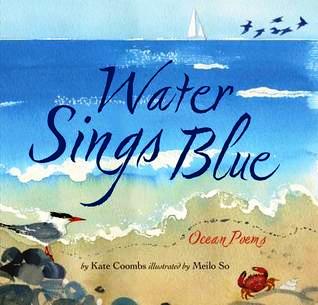By Kate Coombs/ Illustrated By Meilo So
This book of poems centers around the theme of the ocean and the creatures that live in and around it. The end pages introduce the reader to the ocean through the use of sand colored pages with bird footprints, an arm of a crab, a gull feather and a clam shell. The front matter contains an illustration of an ocean wave against the sky (at the beginning and end of the book.) This introduction/conclusion technique serves as a technique to "transport" the reader into and out of the "lyrical world" of the ocean.
The poems are organized in a transitional manner. The reader gets gradually "pulled into" the ocean as the poems progress. For example, the opening poem "Song of the Boat" begins the movement of transport with the words "Push away from the stillness of the nut-brown land.." The second and third poems focus on the birds and sand surrounding the surface of the ocean while the fourth poem and on focuses on underwater wildlife and nature. Each poem is placed either inside, on top of , or
surrounding the illustrations depicting the subject and details of the text. You can see in "Sea Turtle," the title is placed above the backside of the turtle while the poem itself is located below. The turtle appears to be swimming with or towards the "Octopus Ink" illustration. The illustrations clearly serve as a means to create transition, balance and flow among the poems themselves.
The second half of the book "moves" the reader back towards the surface of the ocean towards land. The centerfold with the poem "Ocean Realty" begins this "outward" movement. This poem playfully describes the natural tendency for hermit crabs to search for a bigger shell. This poem acts as a "real-estate listing" by describing the qualities of an oceanfront property. the illustrations of the different shells with the presence of palm trees in the background promotes the coexisting of humans and ocean life.
The final poem, "Tideline" cleverly concludes the book with the text "Don't forget me- I was here, wasss h e r e, wassss h e r e. . ," The final lines of the book create an "echo" effect suggesting the idea of waking from a dream or the gradual awakening of the reader moving back to "reality" while exiting the "lyrical ocean world." The illustration also serves as a conclusion to the book because it contains a warm color palette, the setting of the dark orange sun, and the position of the ocean (moving away from the reader).
By Joyce Sidman/ Illustrated By Rick Allen
Dark Emperor & Other Poems of the Night begins with
“Welcome to the Night,” an invitation in verse “To all of you who crawl and
creep, who buzz and chirp and hoot and peep.” It’s an evening summons to
the animals that wake at dusk to go about their nighttime business, enjoying
the cool, damp shadows.
Sidman introduces readers
to woodland snails, the primrose moth, raccoons, porcupines, the red eft, and
even the Dark Emperor himself, the great horned owl. Among other animals,
there are also poems that mark the coming of the mushrooms and the silent
strength of the oak tree. The book closes with “Moon’s Lament,” where one
creature reflects on the night’s events, questions where everyone has gone, and
mourns the dawning of a new day.
Dark Emperor could well stand on its own as a book of poems, but
the addition of short paragraphs of nonfiction coupled with each poem pushes it
to a new level. Each poem appears on the left of the two page spread with
a small illustration. The right side features a larger illustration and
the descriptive text.
Readers not only are given
a lyrical tour of the nighttime forest, but also learn more details about the
poems’ subjects. For example, we learn that snails have teeth on their tongues,
that while trees produce food during the day, they use the hours of darkness to
make repairs and take in extra water, that baby porcupines are called porcupettes, and that one mushroom can produce two billion spores!
This gorgeous poetry collection, classified as juvenile nonfiction, will be a great addition
to any collection. I purchased this book for my own classroom library and
will use it as a mentor text while teaching lessons in the poetry genre. I was
impressed with not only the poetry and illustrations but also with the
accompanying factual information about the creatures the poem was about. I
highly recommend this book to teachers of all grade levels.




No comments:
Post a Comment